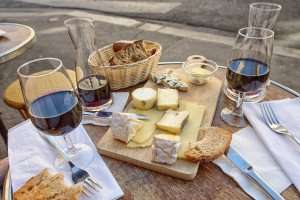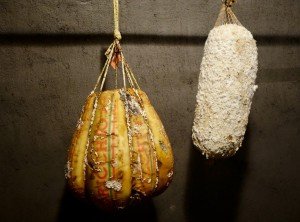Costa Rica's Favorite Meal: The Casado
February 7, 2025
Costa Rica is a fabulous destination for luxury travelers, as well as seniors, couples, and families, not least because of its many excellent dining options.…
Read This Post Everyone loves a cheese plate, so today we’ll talk about how to put one together and how to pair it with wines. Both endeavors can be complicated: there are plenty of categories of cheese and wine to make the whole process seem overwhelming. But if you remember a few simple guidelines, and keep in mind that you will be serving two incredibly tasty items so are almost assured of success, your cheese and wine pairing will be a big hit. Learn the basics of French cheeses. Learn more about cheese and why we love it!
Everyone loves a cheese plate, so today we’ll talk about how to put one together and how to pair it with wines. Both endeavors can be complicated: there are plenty of categories of cheese and wine to make the whole process seem overwhelming. But if you remember a few simple guidelines, and keep in mind that you will be serving two incredibly tasty items so are almost assured of success, your cheese and wine pairing will be a big hit. Learn the basics of French cheeses. Learn more about cheese and why we love it!
 First for the cheese
First for the cheese There are different schools of thought on how to select cheeses for a cheese course, but the most common protocol would call for one “fresh” or mild cheese, one semi-hard, one hard, one blue and one bloomy (stinky). If your’e having a lot of people you can easily double these numbers. So, for example, a Camembert, a Gruyere, a Compté, a Roquefort, and an Epoisse would be a nice French cheese plate. Or a Pecorino Dolce, a Provolone, a Parmigiano Reggiano, a Gorgonzola, and a Taleggio would make a nice Italian selection. Enjoy cheese-making on a culinary tour of Tuscany.  Don’t worry if your selection does not look like what’s pictured here: this cheese board was at a Michelin star restaurant in France! But some examples of the various types of cheese are: Fresh/mild:Ricotta, Mozzarella, Burrata, Robiola, mild Chevre, Feta, Brie, Camembert, Bucheron, Crottin, Brillat-savarin, Halloumi Semi-hard: Havarti, Edam, Gruyere, young Cheddar, Manchego (young), Tomme d’Alsace Hard: aged Cheddar, Comté, aged Gruyere, aged Gouda, aged Pecorino, Manchego, Parmigiano Reggiano, Grana Padano Blue: Stilton, Goronzola, Roquefort, Bleu d’Auvergne Stinky/Bloomy: Epoisse, Taleggio, Morbier
Don’t worry if your selection does not look like what’s pictured here: this cheese board was at a Michelin star restaurant in France! But some examples of the various types of cheese are: Fresh/mild:Ricotta, Mozzarella, Burrata, Robiola, mild Chevre, Feta, Brie, Camembert, Bucheron, Crottin, Brillat-savarin, Halloumi Semi-hard: Havarti, Edam, Gruyere, young Cheddar, Manchego (young), Tomme d’Alsace Hard: aged Cheddar, Comté, aged Gruyere, aged Gouda, aged Pecorino, Manchego, Parmigiano Reggiano, Grana Padano Blue: Stilton, Goronzola, Roquefort, Bleu d’Auvergne Stinky/Bloomy: Epoisse, Taleggio, Morbier  But there are ways to plan your cheese course. A nice twist is to choose different types of milk: so one cow’s milk cheese, one sheep’s milk, one goat’s milk, and perhaps one or two blended. Or, mix up origins by serving one French, one Spanish, one Italian, one English, one American… you get the picture. Make fresh mozzarella on a cooking vacation on the Amalfi Coast.
But there are ways to plan your cheese course. A nice twist is to choose different types of milk: so one cow’s milk cheese, one sheep’s milk, one goat’s milk, and perhaps one or two blended. Or, mix up origins by serving one French, one Spanish, one Italian, one English, one American… you get the picture. Make fresh mozzarella on a cooking vacation on the Amalfi Coast.  A few tips to keep in mind for serving: serve your cheeses with fresh fruit (grapes, apple and pear slices) and nuts, and a selection of honey, jellies, and compotes, with bread or crackers (or both) on the side. And don’t forget to serve them at room temperature, the cold kills the taste of most cheese.
A few tips to keep in mind for serving: serve your cheeses with fresh fruit (grapes, apple and pear slices) and nuts, and a selection of honey, jellies, and compotes, with bread or crackers (or both) on the side. And don’t forget to serve them at room temperature, the cold kills the taste of most cheese.
This will, of course, depend on the cheese. And as with the cheese, you can do an all French tasting, all Italian, or mix it up! Some general rules of thumb:  Fresh/mild cheeses need an equally light wine, so try a white, dry rosé, or light red. Sparklers are also a good option. Try pairing like with like. So yes, pair a French wine with a French cheese, but go even further by pairing within the same region: a Sardinian Cannonau with an aged Sardinian pecorino, or a red Burgundy with an Epoisse, or a Manchego with a fine Amontillado sherry. Learn more about wine and cheese pairing.
Fresh/mild cheeses need an equally light wine, so try a white, dry rosé, or light red. Sparklers are also a good option. Try pairing like with like. So yes, pair a French wine with a French cheese, but go even further by pairing within the same region: a Sardinian Cannonau with an aged Sardinian pecorino, or a red Burgundy with an Epoisse, or a Manchego with a fine Amontillado sherry. Learn more about wine and cheese pairing.  Blue cheeses are strong and often salty, so they can withstand a pairing with a sweet wine: Port, Sauernes, Riesling, Recioto, and Vin Santo are all interesting candidates. Strong reds should be reserved for strong cheeses. Rich, hard cheeses can take the tannins of a strong red, especially if from the same country: so a Chianti with Parmigiano, an Aglianico with Pecorino, a Bordeaux with a good aged Gouda.
Blue cheeses are strong and often salty, so they can withstand a pairing with a sweet wine: Port, Sauernes, Riesling, Recioto, and Vin Santo are all interesting candidates. Strong reds should be reserved for strong cheeses. Rich, hard cheeses can take the tannins of a strong red, especially if from the same country: so a Chianti with Parmigiano, an Aglianico with Pecorino, a Bordeaux with a good aged Gouda.  Semi-hard cheeses can take some reds, but are so versatile they also pair well with oaky whites, young reds, and even sweet wines. For the bloomy/stinky cheeses, sparkling wines work well, as do other “oaky” whites such as Chardonnay or Sauvignon Blanc, lighter reds, or the same sweet wines you might find with the selection of Blues. These cheeses can also stand up to stronger reds if they are equally intense. Travel to France on a food and wine tour with us! Of course, after you blow your budget on a fine selection of cheeses you might not want to also purchase multiple bottles of fine wines! If you have to pick just one option for a cheese plate, try a sparkling wine, Riesling, or Gewürztraminer.
Semi-hard cheeses can take some reds, but are so versatile they also pair well with oaky whites, young reds, and even sweet wines. For the bloomy/stinky cheeses, sparkling wines work well, as do other “oaky” whites such as Chardonnay or Sauvignon Blanc, lighter reds, or the same sweet wines you might find with the selection of Blues. These cheeses can also stand up to stronger reds if they are equally intense. Travel to France on a food and wine tour with us! Of course, after you blow your budget on a fine selection of cheeses you might not want to also purchase multiple bottles of fine wines! If you have to pick just one option for a cheese plate, try a sparkling wine, Riesling, or Gewürztraminer.  Chances are, your guests will be big fans of both wine and cheese, and your audience will be eager to be pleased. So don’t be afraid to play around, and let us know how it goes! Contact us to start planning your next vacation! By Peg Kern Search our blog for more chef interviews, recipes, and destinations features. Sign up to receive our newsletter, which includes travel tips, recipes, promotions, and information on our best culinary vacations. Find more photos, videos, food facts, and travel stories from The International Kitchen on Facebook, Instagram, Pinterest, Twitter, and YouTube.
Chances are, your guests will be big fans of both wine and cheese, and your audience will be eager to be pleased. So don’t be afraid to play around, and let us know how it goes! Contact us to start planning your next vacation! By Peg Kern Search our blog for more chef interviews, recipes, and destinations features. Sign up to receive our newsletter, which includes travel tips, recipes, promotions, and information on our best culinary vacations. Find more photos, videos, food facts, and travel stories from The International Kitchen on Facebook, Instagram, Pinterest, Twitter, and YouTube.